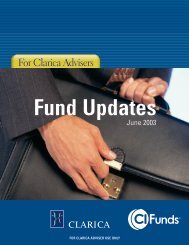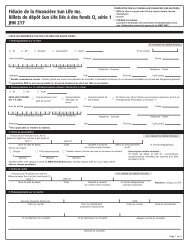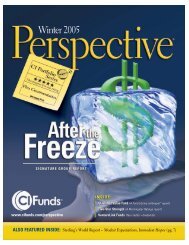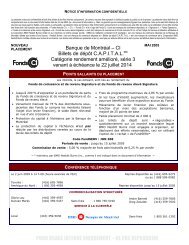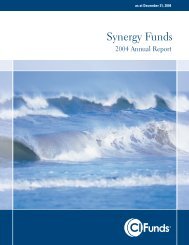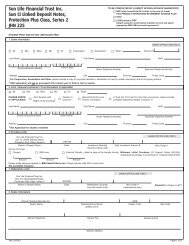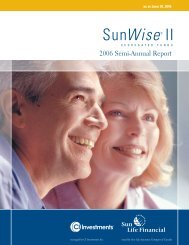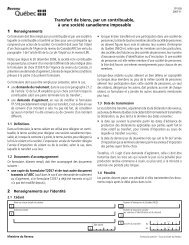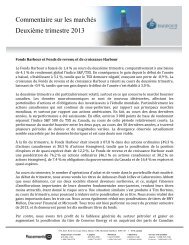July - Summer Edition - CI Investments
July - Summer Edition - CI Investments
July - Summer Edition - CI Investments
Create successful ePaper yourself
Turn your PDF publications into a flip-book with our unique Google optimized e-Paper software.
Tetrem Capital Management Ltd.<br />
Commentary<br />
Daniel Bubis<br />
President and Chief Investment Officer<br />
Since last quarter, financial markets have taken a decidedly<br />
“risk off” perspective as the S&P/TSX Composite Index and<br />
the S&P 500 Index both witnessed corrections in the second<br />
quarter. At the end of the first quarter, our view was and<br />
remains that we are in a bull market. Trying to predict nearterm<br />
fluctuations in share prices is a reactive fool’s game,<br />
which only serves to whipsaw investors. We saw this in the<br />
days leading up to, and coming out of, the <strong>July</strong> long weekend.<br />
Portfolio managers who extended their long weekend by<br />
heading out early missed a market surge, with the S&P/TSX<br />
climbing 5.0% from recent lows and the S&P 500 coming<br />
to within 0.8% of its post-financial crisis highs. Given the<br />
experience over the past few years, the resolve to remain<br />
invested is continually tested.<br />
Investors were psychologically wounded by the 2008 financial<br />
crisis and its aftermath, and the healing process will take<br />
some time. Excessive use of debt in earlier decades has left us<br />
with a legacy of ongoing deleveraging. If the 2008 financial<br />
crisis was the earthquake, debt crises since then have been<br />
its aftershocks. Thus far we have avoided another “big one”<br />
– even though each new aftershock makes investors run for<br />
cover, as they have been conditioned to do so.<br />
Late in 2009, the first aftershock came from Dubai. Dubai<br />
presaged the European sovereign debt crisis, whose tremors<br />
were initially felt in the first half of 2010 when “PIIGS”<br />
(Portugal, Ireland, Italy, Greece and Spain) entered the<br />
investment vernacular. European sovereign woes represent<br />
the most serious aftershocks since the traumatic failure of<br />
Lehman Brothers in 2008. Their epicentre has been Greece<br />
– somewhat ironically the cradle of Western civilization. The<br />
first shock occurred in the first half of 2010 and triggered<br />
corrections in the S&P/TSX and the S&P 500 into <strong>July</strong> 2010.<br />
What was particularly frightening was the risk of financial<br />
contagion spreading to the rest of Europe and the threat to<br />
the global economy of a double-dip recession. Last year’s<br />
Greek crisis eventually stabilized as the economically<br />
stronger northern parts of Europe provided Greece with<br />
stopgap financial backing. Unfortunately, the fault lines run<br />
deep, so here we are one year later with a relapse and a new<br />
round of financial aftershocks.<br />
Euro vs. U.S. dollar<br />
1,7<br />
1,6<br />
1,5<br />
1,4<br />
1,3<br />
1,2<br />
1,1<br />
Dec.<br />
2008<br />
Jun.<br />
2009<br />
Dec.<br />
2009<br />
Source: Bloomberg. As of June 30, 2011.<br />
Crisis I<br />
Jun.<br />
2010<br />
Dec.<br />
2010<br />
Crisis II<br />
Jun.<br />
2011<br />
Chart 1: Despite the current crisis in Greece, this time around the euro has<br />
remained relatively stable against the U.S. dollar. Currently, it is trading around<br />
US$1.40 – a far cry from the US$1.20 it hit during the first Greek crisis.<br />
Interestingly, in this current bout of risk off, the euro has<br />
remained relatively stable, as can be seen in Chart 1. If<br />
the current crisis is so threatening to the European Union,<br />
wouldn’t it be reasonable to expect euro weakness, similar<br />
to last year’s crisis? Exchange rate mechanisms are extremely<br />
complex and are affected by many variables – that is why<br />
predicting a future currency level is nearly impossible. For<br />
instance, the relative stability of the euro now may be more<br />
about investor apathy towards the U.S. dollar than comfort<br />
with the euro. More likely, it has something to do with<br />
the European Central Bank’s hawkish stance on inflation<br />
– a position it may not be able to afford for much longer.<br />
SUMMER 2011 PERSPECTIVE AS AT JUNE 30, 2011 35



